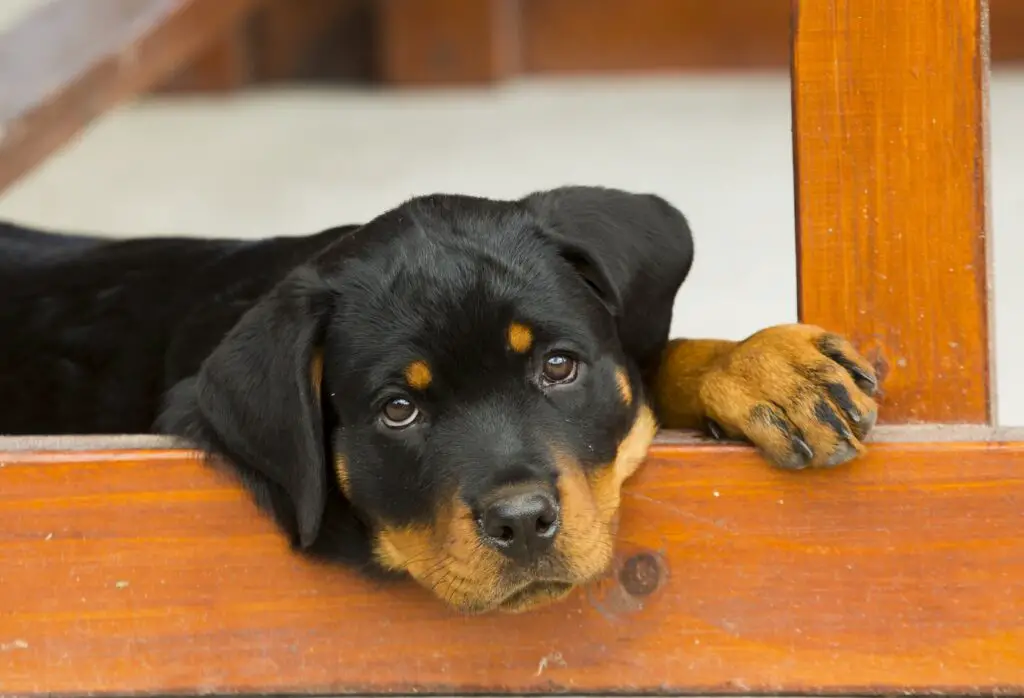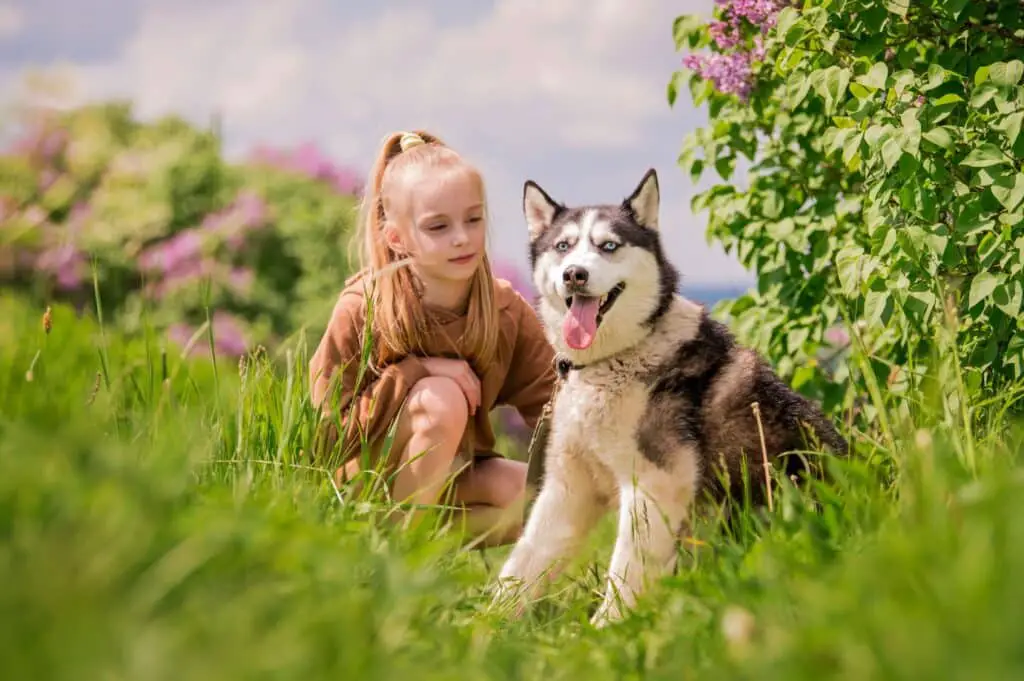If you are thinking about adding a Rottweiler Husky mix to your family, it is important to understand what goes into owning this particular breed.
This article will provide 17 essential facts about this mixed breed, including their temperament, behavior, training, exercise, and grooming needs. We cover it all and aim to provide you with the key information you need before taking the plunge! Read on to find out more.
You may also like – Rottweiler Pitbull Mix – 17 Things to Know
Rottsky – Size and Appearance
The Rottweiler Husky mix, also known as a Rottsky, combines the Rottweiler and Siberian Husky. Known as an athletic and powerful breed, they are a sight to behold when you first see them.
With a thick coat of hair, these dogs weigh between 60 – 100 pounds and can grow up to 24 inches tall.
Along with their sturdy build, they have a rather long head and a tapered muzzle, along with floppy ears. Other notable features are their almond-shaped eyes and bushy tail, which is often seen curled over their back.
Rottsky – Coats and Colors
While the Rottsky will typically vary in color, they are known for their thick double coat with black and tan markings. They will sometimes have white patches on their coast, especially around the chest area and on their paws.
Depending on the breeding, their coat colors can sometimes have red, brown, grey, or sable.
Rottsky – Temperament
The Rottsky is known as highly active, requiring lots of physical and mental exercise to stay happy and healthy. They also are prone to a high prey drive, which stems from their Rottweiler genetics.
On the positive, this mixed breed is highly intelligent, protective, very affectionate, and playful. They tend to be very loyal and protective of their family, and they are usually good with children. It’s important to note that they’re quite independent and stubborn, so training them early is highly recommended.
Rottsky – What Training is required?
While the Rottsky is considered quite intelligent, they are also quite stubborn and independent, which can make training them challenging.
Fortunately, they can learn new tasks very quickly, so dog owners should see results very quickly once their training starts.
You will find that Rottkies will pick up obedience training very quickly, which should commence from 8 weeks of age. Advanced behavioral training can also start once they have mastered the basics.
By progressing their training to more advanced activities, this breed will likely enjoy both the physical and mental benefits it provides.
This is a win-win for all concerned and will also reduce the likelihood of any disruptive behaviors that may occur.
Rottsky – What Exercise is required?
As the Rottweiler Husky mix is super active, their energy levels need to be catered for by their owners. We’re not talking about the occasional walk here either!
This mixed breed will need around 90 minutes of exercise every day, which should be a combination of walks to runs, playing fetch, or other fun activities.
Considering that Rottskies are sometimes prone to overheating as they have a rather thick coat, caution should be given, especially on warmer days.
Rottsky – Mental Stimulation
Along with physical exercise, the Rottsky also requires a great deal of mental exercise and brain activity. As they are an intelligent mixed breed, their minds need to be stimulated as much as their bodies.
There are many activities you can try with your Rottsky that will fulfill their needs. We’ve listed some of them below:
- Hide-and-Seek
- Obstacle Courses
- Treat Dispensing toys
- Find the treats
- Chase the treat
- Treasure hunts
Whichever activity you choose, including brain activities with physical exercise, will go a long way in stimulating your Rottsky, along with having lots of fun at the same time!
Rottsky – Grooming Requirements
As the parent breeds of the Rottsky are known to shed quite heavily, grooming this mixed breed will require some work from its owners.
Brushing their thick coat will be a weekly task; typically two to three times per week will do the job.
Bathing is also required every two to three months. Doing this too often is likely to strip the oils from their coat which you want to avoid.
Their shedding will increase during the spring and fall, so brushing and vacuuming will likely be an everyday activity unless, of course, you are content with dog hair all over the house!
Rottsky – Health Conditions

The Rottweiler Husky mix has its fair share of health issues like most breeds, so it’s important to check with the breeder about any concerns before purchasing.
The common health issues this breed may encounter are outlined below:
Hip Dysplasia: this degenerative condition causes the loosening of the hip joint, causing ongoing pain and weakness. This is typically present in overweight dogs or those that have not been exercised properly.
Elbow Dysplasia: Similar to hip dysplasia, this is another condition common amongst large dog breeds. Dogs with this condition are often lame after exercise and will generally move their affected paws inwards while holding their elbow outwards in the opposite direction.
Bloat: This is a nasty condition that can affect the Rottsky. It occurs when the dog’s stomach is stretched with gas, food, or fluid, putting pressure on other organs in their body.
The key things to watch out for with this condition are a swollen stomach, excessive drooling, panting, and dry retching.
As this condition can be life-threatening, you should take your Rottsky to the Vet immediately to increase their chances of recovery.
Rottsky – Nutrition Requirements
Due to the size and energy levels of the Rottsky, they will typically require around 3 cups of food each day. This will vary depending on their activity levels and how often they are exercised.
While there is no specific diet for this breed, they are best-fed meals made from whole food sources that are high in protein, moderate in fat, and low in carbs.
As they are known for having sensitive stomachs, it’s also best to feed them dog food with ingredients most suited for this easily digestible condition.
Rottsky – Dog Friendly
The Rottweiler Husky mix is considered a dog-friendly breed, although they have known to be dominant with other dogs of the same sex.
And while Rotties are typically an outgoing and friendly breed, they may inherit the Rottweiler’s protective instincts and prey drive.
If this occurs, they are likely to be domineering over smaller dogs unless they are properly socialized.
Socialization is therefore key for this mixed breed. Dog owners should introduce them to other dogs and different types of people during their puppy years to ensure they develop an even temperament.
Rottsky – Child Friendly

The Rottsky is typically friendly with children, however, this will also depend on the traits this mixed breed has inherited.
I’ve found that if a Rottweiler parent is overly protective, this may pass down the line and result in your Rottsky haven’t temperament issues.
On the contrary, if the Husky parent is very easygoing and friendly, this may be the predominant trait in its offspring.
The other main consideration is the size and energy level of this breed. Rottskies are best for children approaching their teenage years, as they could easily knock over and injure a young child that isn’t paying attention.
They can be with kids younger than this, of course, however, this is best done under supervision.
Rottsky – Drooling Levels
Based on the parents of this mixed breed, the Rottweiler Husky mix is considered a medium-level drooler. I know from experience that Rottweilers are partial to a good drool and leave their fair share of slobber around the house!
The Siberian Husky parent is also known to drool occasionally, but not as much as Rotties.
When mixing the two breeds, it’s likely the offspring will be medium droolers.
Keeping in mind that drooling can be triggered in a number of ways, including:
- Dental issues
- Anxiety
- Foreign objects
- Oral infections
- Plant Consumption
- Hypersalivation
- Heatstroke
- Diseases, including Cancer
Rottsky – Barking Levels
When it comes to barking, the Rottsky is considered a moderate barker and will typically only make noise when they are concerned or excited about something.
As both the Rottweiler and Husky parents are moderate barkers, you shouldn’t have too many issues keeping this breed quiet.
Keep in mind that the Rottsky is also known to howl as well; however, this generally becomes less of an issue as they become more mature.
Rottsky – Adaptability to Weather

The Rottsky is generally more comfortable in cooler conditions than in hot temperatures. Due to their thick coats, this breed is prone to overheating and could easily suffer heatstroke if left outside for too long in harsh conditions.
To avoid issues with overheating and dehydration, it is best to keep Rottskies out of the heat once it reaches 80 degrees (F).
Similar to both the Rottweiler and Husky parents, this mix is best suited to a cooler climate and should always be supervised if the temperature increases.
Rottsky – Life Expectancy
The Rottweiler Husky mix will typically have a life expectancy of between 9 and 13 years.
While this may vary depending on genetics and living conditions, this timeframe is based on the average life expectancy of both parent breeds.
Keeping in mind that Lifestyle, nutrition, exercise, health care, and genetics all play a role in how long the Rottsky will live.
Rottsky – AKC Recognition
The Rottsky is not currently recognized by the American Kennel Club (AKC). However, it is recognized by a number of other organizations, including the United Kennel Club (UKC) and the International Canine Association (ICA).
While AKC recognition is not required for all dog breeds, it can be helpful if you are interested in registering your dog for competitions and obtaining insurance.
Rottsky – Puppy Prices
The average price for a Rottweiler Husky mix puppy is $600 and above. but prices typically vary depending on things like the breeder’s experience, the dog’s color, and markings.
Puppies that are born to parents with champion bloodlines may also be more expensive.
You can also check with organizations like the UKC and ICA, as they may have lists of breeders who are members in good standing. And, of course, you can always ask your veterinarian for recommendations.
Don’t Miss – 16 Fun Facts – Rottweiler Rhodesian Ridgeback Mix


